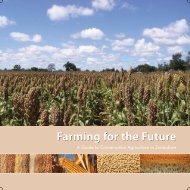Restoring the Soil - Canadian Foodgrains Bank
Restoring the Soil - Canadian Foodgrains Bank
Restoring the Soil - Canadian Foodgrains Bank
You also want an ePaper? Increase the reach of your titles
YUMPU automatically turns print PDFs into web optimized ePapers that Google loves.
Decision Tree Guide45more than 1,000 mm per year. These systems would be <strong>the</strong> same as those in #29.Go to #29.32. Improved fallows where <strong>the</strong> animals are kept away from <strong>the</strong> fields. In <strong>the</strong>seareas, improved fallows can use any one of several species. Try mucuna (Mucunaspp.) (Photos 15 and 23) and pigeon pea (Cajanus cajan), along with <strong>the</strong> jackbeanand tephrosia.23. Honduras. This mucuna was planted in ano<strong>the</strong>rpart of <strong>the</strong> same field as shown in photo 15. Themucuna has only been growing for 45 days, in spiteof <strong>the</strong> poor condition of <strong>the</strong> soil. For extremely poorsoil, jackbeans will grow better than mucuna.24. Honduras. The mucuna we use as a gm/cc must not be confused with <strong>the</strong> itchy type ofmucuna, which has a cover of small hairs on <strong>the</strong>pod (<strong>the</strong> variety to <strong>the</strong> right). This itchy kind shouldnever be used in farmers’ fields. Some farmerstraditionally use <strong>the</strong> itchy kind (e.g., in centralGhana). These farmers should be told that <strong>the</strong> nonitchykind is just as “strong,” meaning it fertilizes<strong>the</strong>ir fields just as well.This may be <strong>the</strong> ideal situation formucuna, a gm/cc species that has, in <strong>the</strong>past, been tried in many situations thatwere not ideal for it. If <strong>the</strong>re is enoughrain mucuna will grow most of <strong>the</strong> year,or will reseed naturally in January (Julyin <strong>the</strong> sou<strong>the</strong>rn hemisphere). The use ofmucuna usually results in a very good,high-nitrogen level improved fallow thatis also very efficient at eliminating mostweeds. The farmer obtains a virtuallyweed-free, fertile soil in 12 months (Photo13). The mucuna seed can be broadcastei<strong>the</strong>r when <strong>the</strong>re is no vegetation because<strong>the</strong> field has just been plowed or <strong>the</strong>vegetation cut, or when <strong>the</strong>re is naturallyvery little vegetation, such as just before<strong>the</strong> rains start (although <strong>the</strong> field musthave been dug or plowed sometime within<strong>the</strong> last year or so). In ei<strong>the</strong>r case, <strong>the</strong>mucuna seed should be planted whenunder normal climatic conditions <strong>the</strong>rewill be significant rainfall for at least <strong>the</strong>following three or four months. The use ofmucuna can restore <strong>the</strong> soil in six monthsto a year. (See, for instance, S1 and S77.The mucuna need not be a perennialmucuna, like that used in Vietnam.)Mucuna is <strong>the</strong> best-known of all <strong>the</strong> gm/cc species (Photo 24). It is also probably<strong>the</strong> most widely used gm/cc species in <strong>the</strong>world, since it is extensively grown in <strong>the</strong>Americas, Asia and Africa. This may seemstrange, given that it produces no easilyedible bean or widely useful by-product.The beans can be eaten, and are high inprotein, but only after some major
















